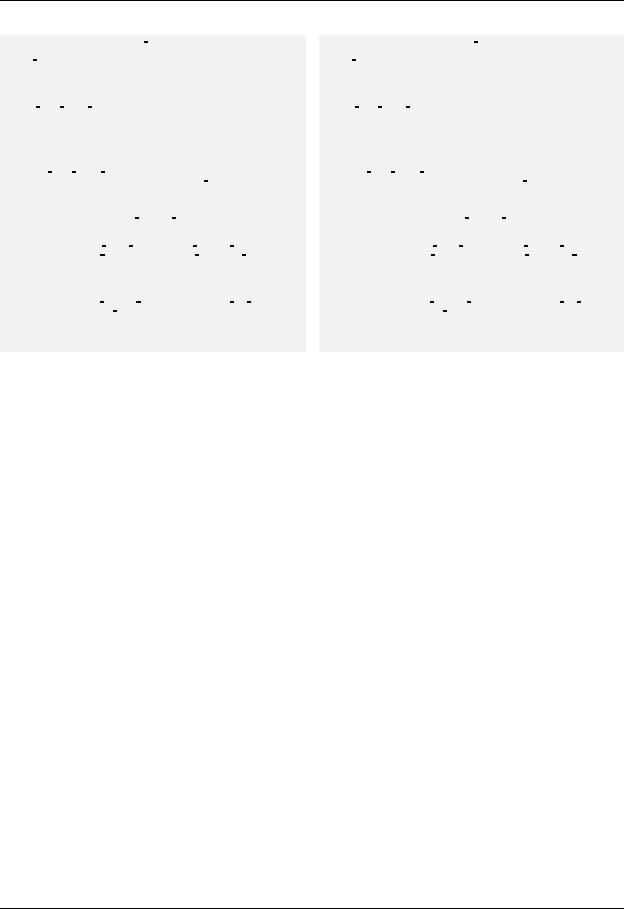
- •Matrix computations on systems equipped with GPUs
- •Introduction
- •The evolution of hardware for High Performance Computing
- •The programmability issue on novel graphics architectures
- •About this document. Motivation and structure
- •Motivation and goals
- •Structure of the document
- •Description of the systems used in the experimental study
- •Performance metrics
- •Hardware description
- •Software description
- •The FLAME algorithmic notation
- •The architecture of modern graphics processors
- •The graphics pipeline
- •Programmable pipeline stages
- •The Nvidia G80 as an example of the CUDA architecture
- •The architecture of modern graphics processors
- •General architecture overview. Nvidia Tesla
- •Memory subsystem
- •The GPU as a part of a hybrid system
- •Arithmetic precision. Accuracy and performance
- •Present and future of GPU architectures
- •Conclusions and implications on GPU computing
- •BLAS on single-GPU architectures
- •BLAS: Basic Linear Algebra Subprograms
- •BLAS levels
- •Naming conventions
- •Storage schemes
- •BLAS on Graphics Processors: NVIDIA CUBLAS
- •Evaluation of the performance of NVIDIA CUBLAS
- •Improvements in the performance of Level-3 NVIDIA CUBLAS
- •gemm-based programming for the Level-3 BLAS
- •Systematic development and evaluation of algorithmic variants
- •Experimental results
- •Impact of the block size
- •Performance results for rectangular matrices
- •Performance results for double precision data
- •Padding
- •Conclusions
- •LAPACK-level routines on single-GPU architectures
- •LAPACK: Linear Algebra PACKage
- •LAPACK and BLAS
- •Naming conventions
- •Storage schemes and arguments
- •LAPACK routines and organization
- •Cholesky factorization
- •Scalar algorithm for the Cholesky factorization
- •Blocked algorithm for the Cholesky factorization
- •Computing the Cholesky factorization on the GPU
- •Basic implementations. Unblocked and blocked versions
- •Padding
- •Hybrid implementation
- •LU factorization
- •Scalar algorithm for the LU factorization
- •Blocked algorithm for the LU factorization
- •LU factorization with partial pivoting
- •Computing the LU factorization with partial pivoting on the GPU
- •Basic implementations. Unblocked and blocked versions
- •Padding and hybrid algorithm
- •Reduction to tridiagonal form on the graphics processor
- •The symmetric eigenvalue problem
- •Reduction to tridiagonal form. The LAPACK approach
- •Reduction to tridiagonal form. The SBR approach
- •Experimental Results
- •Conclusions
- •Matrix computations on multi-GPU systems
- •Linear algebra computation on multi-GPU systems
- •Programming model and runtime. Performance considerations
- •Programming model
- •Transfer management and spatial assignation
- •Experimental results
- •Impact of the block size
- •Number of data transfers
- •Performance and scalability
- •Impact of data distribution
- •Conclusions
- •Matrix computations on clusters of GPUs
- •Parallel computing memory architectures
- •Shared memory architectures
- •Distributed memory and hybrid architectures
- •Accelerated hybrid architectures
- •Parallel programming models. Message-passing and MPI
- •ScaLAPACK
- •PLAPACK
- •Elemental
- •Description of the PLAPACK infrastructure
- •Layered approach of PLAPACK
- •Usage of the PLAPACK infrastructure. Practical cases
- •Porting PLAPACK to clusters of GPUs
- •Experimental results
- •Conclusions
- •Conclusions
- •Conclusions and main contributions
- •Contributions for systems with one GPU
- •Contributions for clusters of GPUs
- •Related publications
- •Publications directly related with the thesis topics
- •Publications indirectly related with the thesis topics
- •Other publications
- •Open research lines
- •FLAME algorithms for the BLAS-3 routines

CHAPTER 6. MATRIX COMPUTATIONS ON CLUSTERS OF GPUS
13 |
/ |
C r e a t e m u l t i s c a l a r s |
one |
and |
m i n o n e . . . |
|
/ |
|
|
|
|
|
|
|
|
||||||||||
/ |
|
|
|
|
|
|
|
|
|
/ |
|
|
|
|
|
|
|
|
|
|
|
|
|
|
|
|
Take |
a v i e w |
( r e f e r e n c e ) |
o f A |
|
|
|
|
|
|
|
|
|
|
|
|
|
|
|||||||
15 |
PLA_Obj_view_all ( a , acur ); |
|
|
|
|
|
|
|
|
|
|
|
|
|
|
|
|||||||||
17 |
while ( |
TRUE ) { |
|
|
|
|
|
|
|
|
|
|
|
|
|
|
|
|
|
|
|
|
|
||
|
|
/ Check d i m e n s i o n o f Acur / |
|
|
|
|
|
|
|
|
|
|
|
|
|
|
|
||||||||
19 |
|
PLA_Obj_global_length |
|
acur , & size |
|
|
); |
|
|
|
|
|
|
|
|
|
|
|
|||||||
21 |
|
/ |
I f |
c u r r e n t |
s i z e |
i s |
0 , |
Acur |
i s |
empty |
/ |
|
|
|
|
|
|
|
|
|
|||||
|
|
i f ( |
( |
size = |
min ( |
size , |
nb_alg ) |
) |
== |
0 |
) |
break; |
|
|
|
|
|
|
|
||||||
23 |
|
/ S p l i t Acur = / A 11 |
|
\ / |
|
|
|
|
|
|
|
|
|
|
|
|
|
|
|||||||
|
|
|
|
|
|
|
|
|
|
|
|
|
|
|
|
|
|||||||||
25 |
|
/ |
|
|
\ A 21 Acur / / |
|
|
|
|
|
|
|
|
|
|
|
|
|
|
||||||
|
|
PLA_Obj_split_4 ( acur , |
size , |
size , |
& a11 , |
|
PLA_DUMMY , |
|
|
|
|
|
|
|
|||||||||||
27 |
|
|
|
|
|
|
|
|
|
|
|
|
|
& a21 , |
|
& acur |
); |
|
|
|
|
|
|
|
|
29 |
|
/ |
Compute t h e C h o l e s k y |
f a c t o r i z a t i o n |
o f |
|
A 11 |
/ |
|
|
|
|
|
|
|
||||||||||
|
|
chol_right_blas2 ( |
a11 |
); |
|
|
|
|
|
|
|
|
|
|
|
|
|
|
|
|
|||||
31 |
|
/ Update A 21 <− A 21 A 11 ˆ(−T) / |
|
|
|
|
|
|
|
|
|
|
|
||||||||||||
|
|
|
|
|
|
|
|
|
|
|
|
|
|||||||||||||
33 |
|
PLA_Trsm ( PLA_SIDE_RIGHT , |
PLA_LOW_TRIAN , |
PLA_TRANS , |
PLA_NONUNIT_DIAG , |
||||||||||||||||||||
|
|
|
|
|
|
|
|
|
|
|
|
|
|
|
|
|
one , |
a11 , |
a21 ); |
||||||
35 |
|
/ Update Acur <− Acur − A 21 A 21 ˆT / |
|
|
|
|
|
|
|
|
|
|
|||||||||||||
|
|
|
|
|
|
|
|
|
|
|
|
||||||||||||||
37 |
|
PLA_Syrk ( PLA_LOW_TRIAN , |
PLA_NO_TRANS , |
min_one , a21 , acur ); |
|||||||||||||||||||||
|
} |
|
|
|
|
|
|
|
|
|
|
|
|
|
|
|
|
|
|
|
|
|
|
|
|
39 |
|
|
|
|
|
|
|
|
|
|
|
|
|
|
|
|
|
|
|
|
|
|
|
|
|
|
PLA_Obj_free ( & a11 ); PLA_Obj_free ( & a21 ); |
PLA_Obj_free ( & acur ); |
|||||||||||||||||||||||
41 |
PLA_Obj_free ( & one ); PLA_Obj_free ( |
|
|
& min_one ); |
|
|
|
|
|
|
|
|
|||||||||||||
43 |
PLA_Temp_set_comm_dir ( template , PLA_DIR_TEMP_ROW , old_dir_row ); |
||||||||||||||||||||||||
|
PLA_Temp_set_comm_dir ( |
template , PLA_DIR_TEMP_COL , old_dir_col ); |
|||||||||||||||||||||||
45 |
} |
|
|
|
|
|
|
|
|
|
|
|
|
|
|
|
|
|
|
|
|
|
|
|
|
|
In the PLAPACK code shown above for the BLAS-3 based implementation of the right-looking |
||||||||||||||||||||||||
|
variant of the Cholesky factorization, the block size b must be initially chosen. Typically, this |
||||||||||||||||||||||||
|
block size equals the width of L21 which makes the symmetric rank-k update most e cient. To |
||||||||||||||||||||||||
|
accomplish that, the PLAPACK infrastructure o ers querying functions to get the optimal value |
||||||||||||||||||||||||
|
for the block size for a given BLAS call (in the example, routine PLA |
|
Environ |
|
nb |
|
alg( ...). Note |
||||||||||||||||||
|
how, in this case, the communication patterns and actual communication calls are encapsulated into |
||||||||||||||||||||||||
|
the (parallel) BLAS calls PLA |
|
Trsm and PLA |
|
Syrk, which gives an overview of how the PLAPACK |
||||||||||||||||||||
|
infrastructure can be used as a library to build higher-level parallel implementations such as the |
||||||||||||||||||||||||
|
Cholesky factorization, without explicitly exposing communication details. |
||||||||||||||||||||||||
6.5. Porting PLAPACK to clusters of GPUs
There are three main reasons underlying the election of PLAPACK as the target infrastructure to port to clusters of GPUs. First, its layered approach yields an easy identification and adaptation of exactly the necessary parts of the library without impact in others. Second, PLAPACK was the origin of the FLAME methodology, which turns the port consistent with the rest of the methodologies and APIs used throughout the rest of the thesis. Third, the object-based nature of PLAPACK allows us to cleanly separate concerns and encapsulate inside the linear algebra object the existence of di erent memory spaces and architectures whithin a node. In addition, communication patterns
188

6.5. PORTING PLAPACK TO CLUSTERS OF GPUS
1 |
i nt |
PLA Chol ( i nt |
b , PLA Obj A |
) |
|
|
i nt |
CUPLA Chol( i nt b , |
PLA Obj A |
) |
|
|||||||
|
{ |
|
|
|
|
|
|
|
|
{ |
|
|
|
|
|
|
|
|
3 |
PLA Obj |
ABR = NULL, |
|
|
|
|
|
PLA Obj |
ABR = NULL, |
|
|
|
|
|
||||
|
|
|
A11 = NULL, |
|
A21 = NULL; |
|
|
|
A11 = NULL, |
|
A21 = NULL ; |
|
||||||
5 |
/ . . . / |
|
|
|
|
|
|
/ . . . / |
|
|
|
|
|
|
||||
7 |
/ |
V i e w |
ABR = A |
/ |
|
|
|
|
|
/ |
V i e w |
ABR = A |
/ |
|
|
|
|
|
|
P L A O b j v i e w a l l ( A, |
&ABR ) ; |
|
|
|
P L A O b j v i e w a l l ( A, |
&ABR ) ; |
|
|
|||||||||
9 |
|
|
|
{ |
|
|
|
|
|
|
|
|
{ |
|
|
|
|
|
|
while ( TRUE ) |
|
|
| | |
|
\ |
while ( TRUE ) |
|
|
| | |
|
\ |
||||||
11 |
|
/ P a r t i t i o n |
ABR |
= / |
A11 |
|
/ P a r t i t i o n |
ABR |
= / |
A11 |
||||||||
|
|
|
|
|
| |
===== |
| | |
===== |
| |
|
|
|
|
| |
===== |
===== |
| |
|
13 |
|
|
|
|
\ |
A21 |
ABR |
/ |
|
|
|
|
\ |
A21 |
| | |
ABR |
/ |
|
|
|
w h e r e A11 i s b x b |
|
|
|
/ |
|
w h e r e A11 i s b x b |
|
|
|
/ |
||||||
15 |
|
P L A O b j s p l i t |
4 ( ABR, b , b , |
|
|
|
|
P L A O b j s p l i t |
4 ( ABR, |
b , |
b , |
|
|
|||||
|
|
|
|
|
|
&A11 , |
PLA DUMMY, |
|
|
|
|
|
&A11 , PLA DUMMY, |
|||||
17 |
|
|
|
|
|
&A21 , &ABR ) ; |
|
|
|
|
|
&A21 , &ABR ) ; |
||||||
19 |
|
/ A11 : = L 1 1 = C h o l e s k y F a c t o r ( A11 ) / |
|
/ A11 : = L 1 1 = C h o l e s k y F a c t o r ( A11 ) / |
||||||||||||||
|
|
PLA Local chol ( PLA LOWER TRIANGULAR, A11 ) ; |
|
CUPLA Local chol( PLA LOWER TRIANGULAR, A11 ) ; |
||||||||||||||
21 |
|
|
|
|
|
|
|
|
|
|
|
|
|
|
|
|
|
|
|
/ U p d a t e A21 : = L 2 1 = A21 i n v ( L 1 1 ’ ) / |
||
23 |
PLA Trsm( PLA SIDE RIGHT , |
PLA LOWER TRIANGULAR, |
|
|
PLA TRANSPOSE, |
PLA NONUNIT DIAG, |
|
25 |
one , A11 , |
|
|
|
A21 ) ; |
|
|
27 |
/ U p d a t e A22 : = A22 − L 2 1 L 2 1 ’ / |
||
|
|||
29 |
PLA Syrk( PLA LOWER TRIANGULAR, PLA NO TRANS, |
||
|
minus one , |
A21 , |
|
31 |
one , |
ABR |
) ; |
|
} |
33 |
/ . . . / |
} |
} |
/ U p d a t e A21 : = L 2 1 = A21 i n v ( L 1 1 ’ ) /
CUPLA Trsm( PLA SIDE RIGHT , |
PLA LOWER TRIANGULAR, |
PLA TRANSPOSE, |
PLA NONUNIT DIAG, |
one , A11 , |
|
A21 ) ; |
|
/ U p d a t e A22 : = A22 − L 2 1 L 2 1 ’ /
CUPLA Syrk( PLA LOWER TRIANGULAR, PLA NO TRANS,
minus one , |
A21 , |
one , |
ABR ) ; |
} |
|
/ . . . / |
|
Figure 6.11: Original PLAPACK code for the right-looking variant of the Cholesky factorization (left). Equivalent accelerated code using GPUs (right).
are limited and can be systematically used without exception. As the number of communication routines is restricted to copy and reduction, the use of accelerators does not imply major changes to neither the user’s code nor the internals of PLAPACK, as explained in this section.
Programmability is the main goal of our port of the PLAPACK infrastructure to clusters of GPUs. Besides the easy methodology proposed by PLAPLACK for the development of new dense linear algebra routines, the existence of a new memory space bound to each GPU in the cluster must remain transparent for the user. Neither explicit memory transfers nor di erent linear algebra routines have to be added to existing codes in order to unleash GPU acceleration. Adding the complexity of managing a new set of memory spaces would imply a new burden to the intricate task of message-passing programming. Only by satisfying this condition can the existing implementations be easily ported to the novel architecture. Looking ahead slightly, the major modifications that will be introduced into the original PLAPACK code will merely consist in changes in the names of the routines, as can be observed by comparing both codes shown in Figure 6.11.
A homogeneous distributed architecture features one independent memory space per node in the system. If accelerators are attached to each node, new independent memory spaces appear bound to each one of them.
The appearance of new memory spaces introduces two di erent possibilities to port the existing implementation. We propose a scheme in which one process is created per accelerator in the system. With this approach, local data bound to each accelerator can be physically stored in either the node main memory (which we call a host-centric storage scheme) or the accelerator memory (which we refer to as a device-centric storage scheme) for the major part of the computation time. The moment in which data is transferred from main memory to the accelerator memory (or vice-versa) is what ultimately di erentiates both implementations.
189

CHAPTER 6. MATRIX COMPUTATIONS ON CLUSTERS OF GPUS
This section describes both implementations, detailing the di erences between them from the viewpoint of the necessary changes on the user’s code and the internals of the PLAPACK infrastructure.
6.5.1.Host-centric storage scheme
The host-centric storage scheme is a naive port of the original PLAPACK infrastructure to hybrid distributed-memory architectures. In essence, the idea underlying this option is similar to that used in the first version of the multi-GPU runtime introduced in Chapter 5.
Following a close approach, data reside in main memory for the major part of the computation. Only when a local BLAS invocation has to be performed, data are temporarily allocated and transferred to the memory of the corresponding GPU, the BLAS execution is performed, and data are retrieved back into its original address in main memory. After data have been used, the associated bu er in GPU memory is destroyed and data are kept exclusively in main memory for the rest of the computation.
The changes required in the infrastructure are limited to the local BLAS module. Using this strategy, the BLAS calls PLA * are in fact wrappers with the following minor modifications:
1.Initially, local bu ers are allocated in GPU memory.
2.Local bu ers in main memory bound to an object are transferred to GPU memory.
3.Local BLAS calls are replaced by GPU-specific BLAS calls (in this case, NVIDIA CUBLAS).
4.The contents of local bu ers in GPU memory are transferred back to main memory upon completion of the BLAS invocation.
5.Local bu ers in GPU memory are destroyed.
No further changes are necessary from the programmer perspective. There are two main characteristics in this approach. First, data reside in main memory of the nodes during most of the computation time. Second, data transfers between main memory and GPU memories are bound exclusively to computations.
The original PLAPACK code would remain unmodified in the accelerated version, provided the corresponding wrappers keep the same name than the original ones. As an example, the code in the left listing of Figure 6.11 can be accelerated by just linking the appropriate BLAS wrappers.
6.5.2.Device-centric storage scheme
A drastically di erent approach to port PLAPACK to accelerated cluster is possible. In the device-centric storage scheme, data reside in GPU memories for the major part of the computations. Only when a node transfer is required, data is temporarily transferred to main memory. On the other side of the communication, data is received in main memory and immediately transferred to GPU memory, where the computation continues. Thus, in this case, data transfers between GPU memories and main memories are bound exclusively to communications.
We describe in this section our approach to retarget PLAPACK to a cluster equipped with hardware accelerators following the device-centric storage scheme. Given that current NVIDIA accelerator boards include a RAM of 4 GBytes, we do not expect that the size of the device memory becomes a limiting factor for most applications. Otherwise, one could still handle the
190

6.5. PORTING PLAPACK TO CLUSTERS OF GPUS
device memory as a cache of the host memory, by implementing a software coherence protocol similar to that introduced in Chapter 5.
In order to describe the changes required by the device-centric approach, we will again consider the right-looking variant for the Cholesky factorization (shown in Section 6.4.2).
Communicating data in the Cholesky factorization
The primary vehicles for communication in PLAPACK are the copy and reduce operations. The approach in this library is to describe the distribution for the input and output using linear algebra objects, and then to copy or to reduce from one to the other. Thus, a prototypical communication is given by the call PLA Copy( A, B ) where included in the descriptors A and B is the information for the respective distributions. The PLA Copy routine determines how data must be packed, which collective communication routine must be called to redistribute them, and how the contents must be unpacked after the communication. What this means is that, with the addition of memory local to an accelerator, the necessary data movement with the host processors that perform the communication needs to be added. This can be accomplished by hiding the details completely within the PLA Copy routine. The PLA Reduce routine allows contributions from di erent processors to be consolidated, and similar implementation details can be encapsulated inside it.
Data Movement in the Cholesky Factorization
Let us focus on the call PLA Trsm( ..., A11, A21 ). In the particular implementation of the Cholesky factorization given in Section 6.4.2, A11 exists within one process and A21 within one column of processors, with all elements of a given row of A21 assigned to the same processor. Inside this routine, A11 is broadcast so that all processors that own part of A21 receive a copy, after which local triangular solves complete the desired computation. The call to PLA Syrk performs similar data movements and local computations. Although PLAPACK includes more complex implementations that require more intricate data movements, we purposely focus on a simple implementation since it captures the fundamental issues.
Necessary changes to PLAPACK
We describe how porting to an exotic architecture, like accelerators with local memories, is facilitated by a well-layered, object-based library like PLAPACK. We do so by exposing a small sampling of the low-level code in PLAPACK and discussing how this code has to be changed. We will employ the copy from a PLAPACK object of matrix type to a second object, of the same type, in order to illustrate the modular structure of PLAPACK and the series of changes that had to be made to accommodate the use of accelerators in PLAPACK. This copy is implemented in routine PLA Copy from matrix to matrix, which we transformed into CUPLA Copy from matrix to matrix. Several cases are treated within the copy routine. For example, when both matrices are aligned to the same template (i.e., the contents are distributed among the nodes following the same pattern), local copies from the bu er containing the elements of the source matrix to the one with those of the target matrix su ce, as shown by the following excerpt of PLAPACK code:
|
/ |
PLAPACK PLA Copy between a l i g n e d |
m a t r i c e s / |
|||
2 |
i f |
( |
align_col_from == |
align_col_to |
) |
{ |
|
|
i f |
( align_row_from |
== align_row_to |
){ |
|
4PLA_Local_copy ( Obj_from , Obj_to ); done = TRUE ;
6 }
}
191

CHAPTER 6. MATRIX COMPUTATIONS ON CLUSTERS OF GPUS
In PLAPACK, the local copy inside PLA Local copy is performed using (several invocations to) the BLAS-1 routine scopy; in our port to clusters of GPUs we invoke the analogous copy counterpart from the CUDA runtime to move data between di erent positions of the device memory. A more elaborate case occurs when the two matrices feature di erent alignments. For simplicity, consider that the matrices share the same column alignment but di er in the row alignment. Thus, each column process has to send the corresponding block to each one of the processes in the same column. For e ciency, before these blocks are sent, they are packed in an auxiliary bu er to hide part of the communication latency by increasing the granularity of messages. This is done in PLAPACK as follows:
1 / PLAPACK PLA Copy between column a l i g n e d m a t r i c e s / while ( TRUE ){
3PLA_Obj_split_size ( from_cur , PLA_SIDE_TOP ,
|
|
& size_from , & owner_from |
); |
|
|
5 |
PLA_Obj_split_size ( |
to_cur , |
PLA_SIDE_TOP , |
|
|
|
|
& size_to , |
& owner_to ); |
|
|
7 |
|
|
|
|
|
|
i f ( 0 == ( size = |
min ( size_from , size_to ) |
) |
) |
|
9break;
11 |
PLA_Obj_horz_split_2 ( from_cur , size , |
|
|
|
||
|
|
& from_1 , |
& from_cur |
); |
|
|
13 |
PLA_Obj_horz_split_2 ( to_cur , |
size , |
|
|
|
|
|
|
& to_1 , |
& to_cur |
); |
|
|
15 |
|
|
|
|
|
|
|
i f ( |
myrow == owner_from && owner_from |
== |
owner_to |
){ |
|
17 |
PLA_Local_copy ( from_1 , to_1 |
); |
|
|
|
|
|
} |
|
|
|
|
|
19 |
e l s e { |
|
|
|
|
|
|
i f |
( myrow == owner_from ) { |
|
|
|
|
21 |
|
PLA_Obj_get_local_contents( from_1 , PLA_NO_TRANS , |
||||
|
|
& dummy , & dummy , buffer_temp , size , |
1 ); |
|
||
23 |
|
|
|
|
|
|
|
|
MPI_Send ( BF ( buffer_temp ), |
|
|
|
|
25 |
|
size * local_width , datatype , |
|
|
|
|
|
|
owner_to , 0, comm_col |
); |
|
|
|
27 |
} |
|
|
|
|
|
|
i f |
( myrow == owner_to ) { |
|
|
|
|
29 |
|
MPI_Recv ( BF ( buffer_temp ), |
|
|
|
|
|
|
size * local_width , datatype , |
|
|
|
|
31 |
|
owner_from , MPI_ANY_TAG , comm_col , |
& status |
); |
||
33 |
|
PLA_Obj_set_local_contents( |
|
|
|
|
35 |
|
|
|
|
||
|
|
PLA_NO_TRANS , size , local_width , |
|
|
||
|
|
buffer_temp , size , 1, |
to_1 ); |
|
|
|
|
} |
|
|
|
|
|
37 |
} |
|
|
|
|
|
|
} |
|
|
|
|
|
39 |
PLA_free ( buffer_temp ); |
|
|
|
|
|
In PLAPACK, routine PLA Obj get local contents copies the local contents of the object into a bu er:
1 |
/ PLAPACK |
P L A O b j g e t l o c a l c o n t e n t s / |
||
3 |
int PLA_Obj_get_local_contents |
( |
||
|
PLA_Obj |
obj , |
int |
trans , |
5 |
int |
* rows_in_buf , |
int |
* cols_in_buf , |
192

6.5. PORTING PLAPACK TO CLUSTERS OF GPUS
|
void |
* buf , |
int |
leading_dim_buf , |
7 |
int |
stride_buf ) |
|
|
9 |
/ . . . |
/ |
|
|
|
for ( j =0; j <n; j ++ ){ |
|
|
||
11 |
tempp_local |
= |
buf_local |
+ |
j* leading_dim_buf * typesize ; |
|
tempp_obj |
= |
buf_obj |
+ |
j* ldim * typesize ; |
13 |
memcpy ( tempp_local , tempp_obj , m* typesize ); |
||||
|
} |
|
|
|
|
15 |
/ . . . / |
|
|
|
|
An equivalent e ect is achieved in our approach with a simple invocation to CUBLAS routine cublasGetMatrix, which packs the data into a contiguous bu er while simultaneously retrieving them from the device memory:
1 |
/ A c c e l e r a t e d P L A O b j g e t l o c a l c o n t e n t s / |
||||
3 |
int CUPLA_Obj_get_local_contents |
( |
|||
|
PLA_Obj |
obj , |
int |
|
trans , |
5 |
int |
* rows_in_buf , int |
|
* cols_in_buf , |
|
|
void |
* buf , |
int |
|
leading_dim_buf , |
7 |
int |
stride_buf ) |
|
|
|
9 |
/ . . . / |
|
|
|
|
|
cublasGetMatrix ( |
m , n , typesize , |
|
||
11 |
|
|
buf_obj , |
ldim , |
|
|
/ . . . |
/ |
buf_local , |
leading_dim_buf ); |
|
13 |
|
|
|
||
Analogous changes are needed in the remaining cases of PLA Copy, as well as PLA Reduce, the second key routine devoted to data duplication and consolidation in PLAPACK, which together embed all data communication (transfer) in PLAPACK. It is important to note that those changes are mainly mechanical, and similar communication schemes are repeated for all cases inside the copy and reduce routines.
Thus, only three of the modules inside the PLAPACK layered infrastructure must be modified to obtain an accelerated version of the whole setup. In fact, those three modules are the whole abstraction layer of the infrastructure, which validates the ability of PLAPACK to accommodate novel architectures (abstracting the rest of the part of the infrastructure), and justifies the decision of precisely porting this library to the accelerated system:
Local BLAS. Local BLAS calls are executed on the GPU, so the corresponding BLAS implementation must be invoked for each PLAPACK local BLAS call. We provide a set of equivalent BLAS routines with the prefix CUPLA to implement this functionality.
Linear Algebra Manipulation routines. Objects are created with an associated bu er in GPU memories. Thus, object creation and manipulation routines must deal with this di erence. We implement a set of alternative implementations with the prefix CUPLA * in order to maintain the functionality of the original calls, but operate with data stored on the GPU.
PLA Copy/Reduce. Communication routines must be modified according to the methodology explained.
With these changes, user’s codes remain basically unmodified. Only the appropriate CUPLA * routines have to be used instead of the existing PLA * invocations when needed. No explicit memory allocations or data transfers between memory spaces are added to user’s codes. As an example,
193
